BLOG, or DIE. Author Bio
Wednesday, 27 April 2011
Were the Founding Fathers Socialists?
 The textbook definition of Socialism is “an economic and political theory, advocating public or common ownership, as well as the cooperative management, allocation and distribution of resources.” Current socialist parties existing in the United States include the Socialist Party USA, the Socialist Workers Party and the Democratic Socialists of America, the latter boasting approximately 10,000 members. Despite the longtime existence of these organizations, the modern socialist movement did not get much attention in the United States until the 2009 election of our current president, Barack Obama. Since then “socialism” has become one of the most inflammatory and misused words in our political vocabulary.
The textbook definition of Socialism is “an economic and political theory, advocating public or common ownership, as well as the cooperative management, allocation and distribution of resources.” Current socialist parties existing in the United States include the Socialist Party USA, the Socialist Workers Party and the Democratic Socialists of America, the latter boasting approximately 10,000 members. Despite the longtime existence of these organizations, the modern socialist movement did not get much attention in the United States until the 2009 election of our current president, Barack Obama. Since then “socialism” has become one of the most inflammatory and misused words in our political vocabulary.
Initially, the term was commandeered by the conservative movement, primarily made up of Republicans, to be used as an accusatory campaign tactic. This was in direct response to the then Democratic candidate Barack Obama’s comments alluding to the expansion of government intervention and redistribution of wealth. It was later used to christen the counter-argument against the Obama Administration’s proposed changes such as government-funded bailouts and universal health care reform. Today it has become a permanent moniker used by the right when describing the president and his liberal policies. Unfortunately, it is also misused continually by Tea Party members, disgruntled GOP supporters and conservative political commentators alike.
I was surprised to find that more than a few political scholars maintain that true socialism was in fact, democratic in nature. Proponents of the system add that it properly prioritizes human needs, thus benefiting a broader stretch of the population. Additionally, many citizens who identify themselves as being on the left, support the notion of incorporating a socialist agenda into the country’s fledgling capitalist system. At the same time political traditionalists and Republican nay Sayers passionately protest the concept and liken it to oppressive forms of government including communism and fascism. Both arguments have merit.
As the country moves further ahead into the president’s first term, little change appears to have manifested on either side of the aisle. In fact, things are worse in some instances as neither party seems able to work together for the betterment of their constituents. Solidarity and compromise are now foreign concepts and the very essence of the two-party system appears to be failing. Yet it is the great debate over socialism that continues to dominate the discussion. It is a winless argument, instrumental in fanning the flames of discontent, and furthering the divide between liberals and conservatives.
Perhaps that is why I was even more surprised to find that some academics are preaching that the concept of American-socialism is nothing new, nor is it contrary to many of the Founding Father’s principles. Mark Brown, holder of the Newton D. Baker/Baker and Hostetler Chair at Capital University School of Law, says that in the midst of the current furor over health care reform legislation we should remember that America's own revered Founding Fathers authorized, and sometimes embraced socialist-like philosophies. In an editorial posted on JURIST he writes, “Many of our Founding Fathers were socialists. They believed that essential services should be provided by government to the public at large for little or no remuneration. The costs of these services would be shared by the whole. This, by most modern accounts, is socialism.”
Several historical quotes have been used repeatedly in these kinds of commentaries to support the notion that although they were not in favor of a total socialist system, some Founders did support the overall principle and as a result, the foundation of which our nation operates has socialist influence and flavor. (That ought to piss the Tea Party off.) Two individuals who are credited with sharing this mindset were Thomas Jefferson and Thomas Paine.
In his 1797 pamphlet titled Agrarian Justice, Thomas Paine outlined the concept for a nationwide account (like Social Security) that would be distributed among the people. He wrote: “[I shall] Create a national fund, out of which there shall be paid to every person, when arrived at the age of twenty-one years, the sum of fifteen pounds sterling as a compensation in part for the loss of his or her natural inheritance by the introduction of the system of landed property. And also, the sum of ten pounds per annum for life, to every person now living, of the age of fifty years, and to all others as they shall arrive at that age.”
In 1811, Jefferson penned a letter to Thaddeus Kosciusko that outlined the concept of spreading wealth around to those less fortunate. He wrote: “The rich alone use imported articles, and on these alone the whole taxes of the General Government are levied... Our revenues liberated by the discharge of the public debt, and its surplus applied to canals, roads, schools, &tc., the farmer will see his government supported, his children educated, and the face of his country made a paradise by the contributions of the rich alone - without his being called on to spend a cent from his earnings.”
It is important to note that these quotes may be taken out of context. Personally, I don't think the Founders were what we would consider today to be Socialists. I don't believe the current administration is either. That said, I do think that we are just beginning to see what kind of long-term damage partisan stubbornness in government can do. Change is certainly needed. Whether it can be achieved through the broadening of political ideologies remains to be seen. Perhaps by re-examining our history and the diversity of our Founder's principals we can come to some kind of compromise that will be in the best interests of the country instead of the best interests of the politicians.

Tuesday, 26 April 2011
Dining with the Swamp Fox
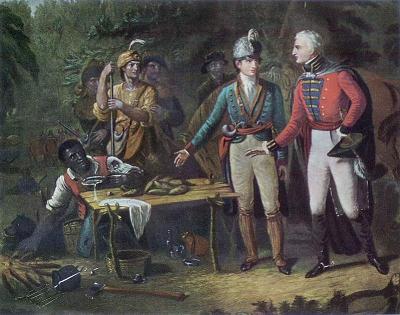 I received a lot of interesting feedback from my April 19th post dealing with the painting The Prayer at Valley Forge. Today I would like to examine another piece of artwork that has been the subject of debate.
I received a lot of interesting feedback from my April 19th post dealing with the painting The Prayer at Valley Forge. Today I would like to examine another piece of artwork that has been the subject of debate.
This oil on canvas painting titled General Marion Inviting a British Officer to Share His Meal, by South Carolina artist John Blake White, was presented to the U.S. Senate in 1899. According to a senate publication on the piece:
The artist has painted the red-coated British officer and Marion at right center, with a horse. Marion wears a plumed shako. His soldiers present an amusingly motley crew. Of special interest is the African American man behind the table, holding a small pan and, with his right hand, roasting sweet potatoes in the fire. This figure was likely meant to represent Marion’s slave or manservant, although Samuel Weaver’s pension application maintains that Weaver himself, a white soldier, was the one who cooked the meal. The makeshift table has a number of sweet potatoes on it, and Marion gestures toward them.
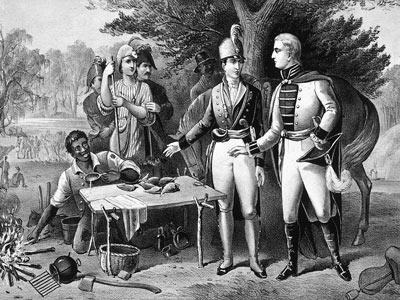 White’s portrayal was made into this mezzotint print by John Sartain in 1840 for the Apollo Association for the Promotion of the Fine Arts in the United States. The image was later used on the 1861 Confederate ($5) banknotes that were issued by South Carolina. An exhibition catalogue dramatically described the story behind the image this way:
White’s portrayal was made into this mezzotint print by John Sartain in 1840 for the Apollo Association for the Promotion of the Fine Arts in the United States. The image was later used on the 1861 Confederate ($5) banknotes that were issued by South Carolina. An exhibition catalogue dramatically described the story behind the image this way:
After the business had been arranged, Marion invited the visitor to take dinner with him. The moment chosen by the Artist is when they approach the table, which was composed of pieces of bark, bearing a dinner of sweet potatoes. The expression of surprise on the countenances of the stranger and Marion’s men is finely expressed. The scenery is said to be perfectly characteristic of a South Carolina swamp; and, altogether, it may safely be pronounced one of the best pictures of American history ever produced in this country.
This version became the accepted interpretation of the piece until James P. Truluck, a descendant of the alleged British Officer, accused it of being revisionist history. According to Truluck, the depicted roles of Marion as host and the Englishman as guest were actually reversed. According to Truluck (in an 1989 article in Carologue, the journal of the South Carolina Historical Society), Captain John Brockington, Jr.—a landowner, slave-owner, and Tory sympathizer, who had fought against the “Swamp Fox”—was the legendary officer depicted in the piece. He added that his ancestor had been among the Tories that were banned to Nova Scotia after Continental forces assumed control of South Carolina.
In an effort to regain his land and reputation, Brockington returned to the colonies to refute his Loyalists ways and repay any claims that were made against him. After receiving a pardon, he and his slaves headed home and traveled through the swamps to avoid confrontation. It was while preparing their own camp meal that Truluck states Marion found them (resulting in the painted scene). He added that Brockington had extended an invitation to the “Swamp Fox” to join them - and joked that Marion had done the same.

Friday, 22 April 2011
Ben in the 'Burg
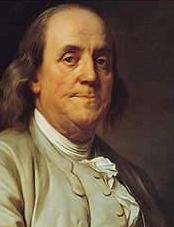 The Senator John Heinz History Center in Pittsburgh has just opened a wonderful exhibition titled “Ben Franklin, In Search of a Better World”. The 8,000 square-foot exhibit, which features more than 150 artifacts and nearly 30 hands-on interactive activities, will immerse visitors in Franklin's world and provide new insights on many previously unknown aspects of his amazing life, including his connections to Western Pennsylvania. A special section of the exhibit is dedicated to Franklin's ties to Western Pennsylvania. In 1755, Franklin obtained nearly 150 wagons from farmers throughout Pennsylvania that were used during General Edward Braddock's failed attempt to capture Fort Duquesne from the French. The incident was later referred to by Franklin in his autobiography as "the wagon affair."
The Senator John Heinz History Center in Pittsburgh has just opened a wonderful exhibition titled “Ben Franklin, In Search of a Better World”. The 8,000 square-foot exhibit, which features more than 150 artifacts and nearly 30 hands-on interactive activities, will immerse visitors in Franklin's world and provide new insights on many previously unknown aspects of his amazing life, including his connections to Western Pennsylvania. A special section of the exhibit is dedicated to Franklin's ties to Western Pennsylvania. In 1755, Franklin obtained nearly 150 wagons from farmers throughout Pennsylvania that were used during General Edward Braddock's failed attempt to capture Fort Duquesne from the French. The incident was later referred to by Franklin in his autobiography as "the wagon affair."
On display: One of the first books Franklin printed, "Religion of Nature Delineated," an original copy of the 1787 U.S. Constitution, a signed copy of Franklin's Bible, rarely displayed personal objects such as books, a chess set, china, furniture and coins, Franklin's inventions, including bifocals, the Franklin stove, the armonica (glass musical instrument), and microscope, as well as a display which highlights pop culture references related to Franklin, featuring everything from Franklin advertising campaigns, mugs, pins, masks, and even bobbleheads. For more information visit the exhibition webpage. You can also view a video of the artifacts courtesy of WDUQ.
I hope to visit the exhibit in person this weekend and provide a detailed photo-essay and synopsis of the experience upon my return.

Thursday, 21 April 2011
An exceptional film. A tremendous loss.
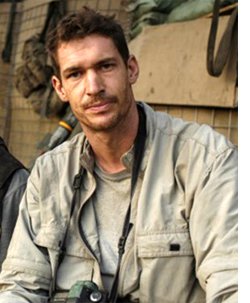 It’s just after midnight on Wednesday and I really should be in bed. My day job with the U.S. Marshals Service demands a 4:30 am wake-up call followed by a 1.5 hour train commute. Any responsible adult would have hit the sack hours ago, but what the hell…I’ve already accepted the fact that tomorrow I probably won’t be worth a damn anyway. Why am I still awake? I just finished watching what may be the best short film that I have ever seen.
It’s just after midnight on Wednesday and I really should be in bed. My day job with the U.S. Marshals Service demands a 4:30 am wake-up call followed by a 1.5 hour train commute. Any responsible adult would have hit the sack hours ago, but what the hell…I’ve already accepted the fact that tomorrow I probably won’t be worth a damn anyway. Why am I still awake? I just finished watching what may be the best short film that I have ever seen.
It’s called Restrepo and it tells the incredible life and death story of a forward-deployed U.S. platoon in Afghanistan, operating in the Korengal Valley. It’s raw, visceral, and makes you proud to be from a country where boys like this are raised. It was released by National Geographic Entertainment, nominated for an Oscar (Best Documentary) and won the 2010 Sundance Film Festival Grand Jury Prize. Film critic Peter Travers outlined this remarkable movie's plotline for his review in Rolling Stone Magazine:
Here's a documentary that embeds you deep into the war in Afghanistan. Filmmakers Tim Hetherington and Sebastian Junger follow a platoon of U.S. soldiers, the Second Platoon, Battle Company, 173rd Airborne Brigade, during their 14-month deployment to the Korengal Valley. The troops are shaken when their beloved medic, Juan "Doc" Restrepo, is killed in action. That’s when Capt. Dan Kearney pulls out all the stops to allay fears even in the Taliban war zone. Naming their base after Restrepo, these soldiers are seen dealing with death on a daily basis. The filmmakers offer no commentary. We watch. And what we see is explosive, deeply moving and impossible to shake.
As a documentary producer, I am ashamed to say that I only learned of this film today after reading a report that its director/co-producer was killed while covering the fighting in Misratah, Libya. Another photojournalist was killed in the attack and several others on their crew were badly wounded. This seems to be the same sad story that we have heard all too often in recent years…some son of a bitch in a towel with an RPG pops out of a hole and takes a potshot at the good guys. I guess these insurgents and rebels think that the media makes just as good a target as soldiers do. It speaks to their cowardice as attacks on the press have ramped up all over that part of the world. I guess if you can’t hit the guys with guns, aim at the guys with cameras. Bastards.
The brilliant mind behind this film is, or was, Tim Hetherington, a highly respected British journalist and filmmaker. He was an experienced, imbedded-correspondent with an amazing talent for stripping away all the political bullshit to reveal the tragic simplicity of war. I read several interviews with him this evening and one statement in particular jumped out at me. He said, “I’ve come to realize the war machine is, in fact, very human. Take a group of young men, train them together, put them on the side of a mountain and they will kill and be killed for each other.” That sums it up.
As someone living in VA and working in DC, I know soldiers that were deployed to Afghanistan, as well as some contractors that are there now. THESE guys are the real heroes. They volunteer to do the most dangerous jobs – in the most dangerous places. And they do it to protect us and improve the lives of uncivilized people who hate them. The debt we owe them can never be paid in full.
Afghanistan is a mess. It is an undeveloped bastion of ‘suck’ on a good day, so I can’t even begin to imagine what daily firefights and mortar attacks does for the place. Yet here we have a team of documentary filmmakers, right in the thick of it, getting incredible footage while ducking bullets and tracers. The result is an intimate portrait, plucked from the chaos of combat that cannot be duplicated any other way.
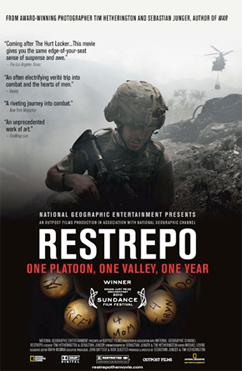 Unlike most films today, Restrepo doesn’t have any fancy graphics or special effects. The instrumental song that plays the audience in and out of the film was performed live by a soldier with a dirty acoustic guitar. Some of the footage is gritty and blurry and so freaking real you get a knot in the pit of your stomach as you watch it. The stress level that these soldiers experienced is shared beyond the screen as you too find yourself anticipating the danger that lies around the bend. Several of the troops are shot and killed during the film, reinforcing the fact that this is reality-TV for real.
Unlike most films today, Restrepo doesn’t have any fancy graphics or special effects. The instrumental song that plays the audience in and out of the film was performed live by a soldier with a dirty acoustic guitar. Some of the footage is gritty and blurry and so freaking real you get a knot in the pit of your stomach as you watch it. The stress level that these soldiers experienced is shared beyond the screen as you too find yourself anticipating the danger that lies around the bend. Several of the troops are shot and killed during the film, reinforcing the fact that this is reality-TV for real.
I never met Mr. Hetherington, nor was I aware of his contributions to the world until today. Unfortunately it is only after his untimely death that I am now discovering an amazing body of work from print and television - to film and photo.
Our documentary projects at Right Stripe Media are historic and take place on Civil War battlefields and Wild West sites hundreds of years after the fighting ended. If we want to show the carnage, we recreate battles and gunfights with re-enactors and pyrotechnics. The only danger we face on one of our shoots is sunburn or maybe eye strain from spending too much time at the computer. So it’s a very sincere gesture when I say that I want to tip my hat to all of these battlefield filmmakers, especially Tim Hetherington for having the vision, and the balls, to create movies like Restrepo.
Real war-journalists, the “Hetheringtons” of the world, risk life and limb to visually preserve and present history as it unfolds. Our production group’s mantra is that we create living history. Tim and his comrades capture it. He will be missed by many, now including me. And although I may never produce a documentary with the soul of Restrepo, I am inspired to try, now more than ever.
ADDED 4/21: Our friend Jared Frederick over at History Matters had the pleasure of meeting and speaking with Tim Hetherington a few months ago. He posted a wonderful blog piece on February 22nd detailing the experience.

Wednesday, 20 April 2011
Homeward Bound
My posts will be far and few over the next week as I prepare for my upcoming lecture and screening at the CarnegieCarnegie Library and Music Hall’s 6th Annual Civil War Weekend. You may recall that we held our ‘northern’ premiere of “The Angel of Marye’s Heights” documentary at this venue back in November. It was an absolute thrill for me as Pittsburgh PA is my hometown and I was able to share the experience with plenty of friends and family. This event looks to be even better (see schedule) and I hope to become a recurring participant. On Saturday April 30th, I will be giving a lecture titled “Gallant Boys of the 123rd,” which presents the experiences of the PA Volunteers at the Battle of Fredericksburg. That will be followed by a screening of “The Angel” w/ a producer Q&A. Once that is finished I get to do it all over again. In addition to our traveling exhibit that features a kiosk, props and handouts, I will be joined by Pittsburgh author Scott Lang who wrote The Forgotten Charge: The 123rd Pennsylvania at Marye's Heights, Fredericksburg, Virginia. Scott has a wonderful collection of 123rd relics that he will be displaying at an adjacent table. I will have copies of “The Angel” DVD for sale ($12) as well as Will White’s soundtrack CD ($10). I’ll also have photos and video to share upon my return. I will be hosting 2 film screenings and a book signing at the Manassas Museum on May 15th (details to come).

Newer | Latest | Older
 The textbook definition of Socialism is “an economic and political theory, advocating public or common ownership, as well as the cooperative management, allocation and distribution of resources.” Current socialist parties existing in the United States include the Socialist Party USA, the Socialist Workers Party and the Democratic Socialists of America, the latter boasting approximately 10,000 members. Despite the longtime existence of these organizations, the modern socialist movement did not get much attention in the United States until the 2009 election of our current president, Barack Obama. Since then “socialism” has become one of the most inflammatory and misused words in our political vocabulary.
The textbook definition of Socialism is “an economic and political theory, advocating public or common ownership, as well as the cooperative management, allocation and distribution of resources.” Current socialist parties existing in the United States include the Socialist Party USA, the Socialist Workers Party and the Democratic Socialists of America, the latter boasting approximately 10,000 members. Despite the longtime existence of these organizations, the modern socialist movement did not get much attention in the United States until the 2009 election of our current president, Barack Obama. Since then “socialism” has become one of the most inflammatory and misused words in our political vocabulary.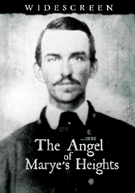
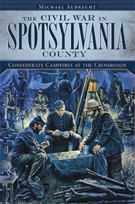
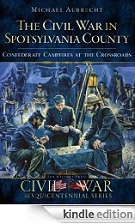



 I received a lot of interesting feedback from my April 19th post dealing with the painting
I received a lot of interesting feedback from my April 19th post dealing with the painting  White’s portrayal was made into this mezzotint print by John Sartain in 1840 for the Apollo Association for the Promotion of the Fine Arts in the United States. The image was later used on the 1861 Confederate ($5) banknotes that were issued by South Carolina. An exhibition catalogue dramatically described the story behind the image this way:
White’s portrayal was made into this mezzotint print by John Sartain in 1840 for the Apollo Association for the Promotion of the Fine Arts in the United States. The image was later used on the 1861 Confederate ($5) banknotes that were issued by South Carolina. An exhibition catalogue dramatically described the story behind the image this way: The Senator John Heinz History Center in Pittsburgh has just opened a wonderful exhibition titled “Ben Franklin, In Search of a Better World”. The 8,000 square-foot exhibit, which features more than 150 artifacts and nearly 30 hands-on interactive activities, will immerse visitors in Franklin's world and provide new insights on many previously unknown aspects of his amazing life, including his connections to Western Pennsylvania. A special section of the exhibit is dedicated to Franklin's ties to Western Pennsylvania. In 1755, Franklin obtained nearly 150 wagons from farmers throughout Pennsylvania that were used during General Edward Braddock's failed attempt to capture Fort Duquesne from the French. The incident was later referred to by Franklin in his autobiography as "the wagon affair."
The Senator John Heinz History Center in Pittsburgh has just opened a wonderful exhibition titled “Ben Franklin, In Search of a Better World”. The 8,000 square-foot exhibit, which features more than 150 artifacts and nearly 30 hands-on interactive activities, will immerse visitors in Franklin's world and provide new insights on many previously unknown aspects of his amazing life, including his connections to Western Pennsylvania. A special section of the exhibit is dedicated to Franklin's ties to Western Pennsylvania. In 1755, Franklin obtained nearly 150 wagons from farmers throughout Pennsylvania that were used during General Edward Braddock's failed attempt to capture Fort Duquesne from the French. The incident was later referred to by Franklin in his autobiography as "the wagon affair." It’s just after midnight on Wednesday and I really should be in bed. My day job with the U.S. Marshals Service demands a 4:30 am wake-up call followed by a 1.5 hour train commute. Any responsible adult would have hit the sack hours ago, but what the hell…I’ve already accepted the fact that tomorrow I probably won’t be worth a damn anyway. Why am I still awake? I just finished watching what may be the best short film that I have ever seen.
It’s just after midnight on Wednesday and I really should be in bed. My day job with the U.S. Marshals Service demands a 4:30 am wake-up call followed by a 1.5 hour train commute. Any responsible adult would have hit the sack hours ago, but what the hell…I’ve already accepted the fact that tomorrow I probably won’t be worth a damn anyway. Why am I still awake? I just finished watching what may be the best short film that I have ever seen. Unlike most films today, Restrepo doesn’t have any fancy graphics or special effects. The instrumental song that plays the audience in and out of the film was performed live by a soldier with a dirty acoustic guitar. Some of the footage is gritty and blurry and so freaking real you get a knot in the pit of your stomach as you watch it. The stress level that these soldiers experienced is shared beyond the screen as you too find yourself anticipating the danger that lies around the bend. Several of the troops are shot and killed during the film, reinforcing the fact that this is reality-TV for real.
Unlike most films today, Restrepo doesn’t have any fancy graphics or special effects. The instrumental song that plays the audience in and out of the film was performed live by a soldier with a dirty acoustic guitar. Some of the footage is gritty and blurry and so freaking real you get a knot in the pit of your stomach as you watch it. The stress level that these soldiers experienced is shared beyond the screen as you too find yourself anticipating the danger that lies around the bend. Several of the troops are shot and killed during the film, reinforcing the fact that this is reality-TV for real.